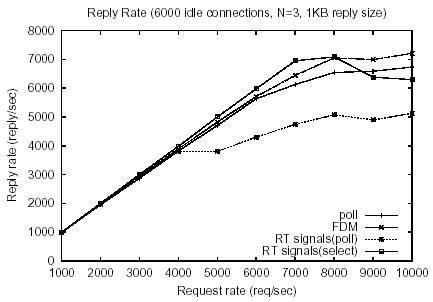


Next: Bibliography
Up: A Scalable Locality-Aware Event
Previous: Temporal-locality-aware poll
Performance Evaluation
On our modified memory-based event-driven web server, three event
dispatching mechanisms: poll(), temporal locality-aware poll
and RT signals are implemented. Parameters of the web server are
optimized for each event dispatching mechanisms to be tested. Server
sleep frequency is fine tuned for maximum performance. Our server
does multiple accept() on a listening socket descriptor when
poll() reports a ready event on the descriptor. This strategy
minimizes the effect of the overhead on poll(). Because more
connections are accepted and more useful works will be identified by
follow-up poll().
 (a)Reply Rate
(a)Reply Rate
|
 (b)Request Rate
(b)Request Rate
|
Figure 2:
Performance with 6000 idle connections
To observe the behavior of FDM library and RT signals as in Figure
2, we increase the number of
idle connections to 6000. The advantage of FDM is clear and obvious.
FDM-based web server delivers highest throughput and shortest
response time. However, it is surprising that the performance of RT
signals(poll) falls behind even that of traditional poll()
when request rate are greater than 4000 req/sec. The reason is
because we use poll() to handle lost event when the signal
queue is overflowed. To use poll() with RT signals, web server
has to prepare and maintain a pollfd array for such signal
queue overflow emergency. Rearranging this pollfd array on
every several calls and the timeout time-stamp array is costly in
proportion to number of idle connections. At 6000 idle connections,
RT signals web server spends much more time on the work we just
mentioned than the time spent at 1000 idle connections. When client
request rate is greater than 4000 req/sec, signal arrival rate become
faster than signal dequeue rate. This results in many SIGIO
signal queue overflow events and significantly increase of response
time. This performance drop scenario can't be observed when server is
loaded with just 1000 idle connection.
Figure 2 also shows the performance
improvement of RT signals(select) over RT signals(poll). The reply rate and the
response time of RT signals(select) is the best over all event dispatching
mechanisms when request rate is smaller than 8000 req/sec. When request rate is
greater than 8000 req/sec, excessively switching back and forth between RT
signals and select() when RT signal queue is overflowed makes the
performance drop. The performance of FDM also starts overtaking RT signals
(select) at 8000 req/sec. RT signal queue overflow problem greatly influences
the performance of both RT signals(poll) and RT signals(select) at different
load.
To conclude this paper, we proposed a user-mode library solution
extends poll() by exploiting temporal locality property among
events in a file descriptor. Each descriptor is associated with a
live counter and polling frequency of a descriptor is determined by
the counter. We have shown that this scheme performs pretty well on
a large number of idle connections.



Next: Bibliography
Up: A Scalable Locality-Aware Event
Previous: Temporal-locality-aware poll
2003-03-23

